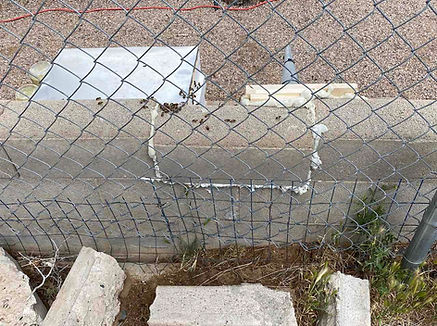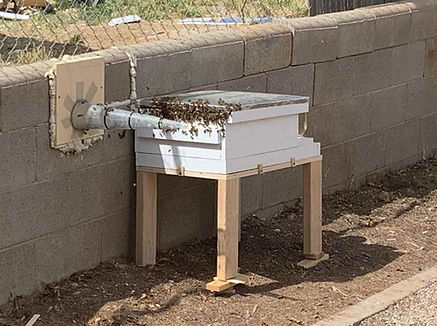Honey Bee Trap Out in Paradise Hills
May 30, 2020
In late April, I received a phone call from a husband and wife in the Paradise Hills Neighborhood about some honey bees that had taken up residence in a cinder block wall in their back yard.
When I arrived at their house, I noticed that the top block had become loose which created hole for the bees to enter the wall. It was unclear how large the hive was in the wall, but the bees appeared to be a little defensive.
The homeowners told me that the bees had been there for couple of years and had swarmed the previous year.

I gave the homeowners the standard two options: 1) open up the wall and remove the bees and comb or 2) perform a trap out.
After explaining the pros and cons of each approach, the homeowners chose the trap out option. They were willing to deal with the bees for the requisite 4-6 weeks to complete the trap out.

The next week I built a trap that consisted of a piece of pine with a small hole in it a cone made out of 1/8" wire mesh.
I also built a hive stand that would position the catch hive at the same height as the trap.
The idea behind the trap is that the bees leave the hive and exit the end of the cone. When they return to the hive, they try to re-enter the hive a the base of the cone. They are not able to enter because it's sealed.
They are provided an alternative hive where they can take up residence. In this case, it was an empty Langstroth hive with 3 quarts of sugar water and little bit of swarm lure on the frames.
Before I left the bees alone, I went around the loose cinder block and sealed it with spray foam to ensure there were no other entrances into the hive.
If they can find another way to get into the hive, then it totally defeats the trap.
The adjacent cinder blocks had plenty of holes. So, I stayed and observed the bees for a while to make sure the returning bees weren't able to get into the hive.
It doesn't hurt to apply a little extra spray foam.

I left the bees alone for about weeks before returning to check on them. When I came back, I didn't see any bees around the trap. Although, I saw a ton of bee on the entrance to the hive.

I decided to open the hive and search for evidence of a queen. After four weeks, I wasn't very hopeful that she had entered the hive.
While I saw a ton of bees and stored sugar water, there was no brood and no queen.
I was faced with a decision to pack up the bees and leave or keep them there a little while longer to see if the queen would emerge and take up residence in the hive. This was an important stage of the trap out and I needed to consider my options carefully.
The previous afternoon, I received a phone call from a wonderful couple in the North Valley who had a queen but no bees. I told them that I may have some bees that they could combine with their queen.
When I saw that there was no queen in the hive, I felt like this was the perfect opportunity to get bees to some new beekeepers.
So, I packed up the bees in my transportable beehive, and headed over to the North Valley area.
When I arrived at the North Valley residence, I was greeted by a very friendly couple who were embarking on a new journey into beekeeping.
They wanted to use a Warre hive that they had built. This presented some challenges, but we came up with a solution that would work.
We ended up cutting out honeycomb from the Langstroth frames and sliding them into the Warre boxes with wooden spacers to keep them separated.

Then, we put the queen cage in the corner of the bottom box. My recommendations to them were to keep the queen caged for at least 24 hours to allow the bees to get used to the new queen. After 24 hours, pull the cork and put a small marshmallow in its place.
The last time I talked to the North Valley couple, everything was going great and they were delighted to have a beehive full of bees.